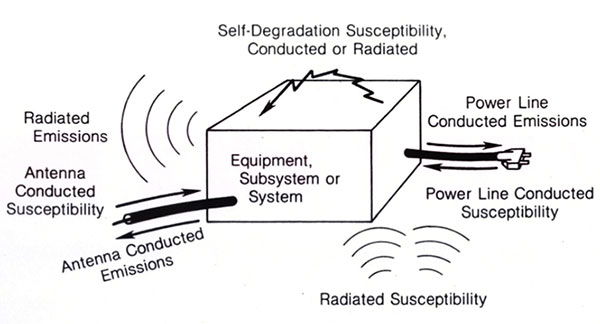Cleansing the Air on Dirty Energy
I recently noticed an odd-looking gizmo plugged into a wall outlet at a friend's house. The gizmo turned out to be a filter billed as being capable of eliminating electrical pollution or dirty energy. The manufacturer of this device claims, “By reducing the intensity of ...high-frequency microsurges the filters effectively diminish the amount of electrical pollution, “dirty electricity”, in your environment, and hence, the most harmful type of electrical frequencies.”
Reading this, my BS detector went off. I've checked the power line emissions of a few switching power supplies and other nonlinear loads and never found conducted emissions that were much above the noise level of my measuring instrument. This is unsurprising. Consumer gear generally must meet EMI limits spelled out in EN55011 and FCC Part 15 standards. All these standards specify that conducted levels must stay below about 1 V.
Nevertheless, the website for the gizmo claims that dirty energy can cause “headaches, fatigue, facial flushing, numbness, sensitivity to lights and sound, tingling loss of taste and smell,” and even worse symptoms. Well, call me skeptical. I was ready to plunk down about $50 to get one of these filters for testing and a teardown. But I discovered that the Consumer and Clinical Radiation Protection Bureau for Health Canada had already done the work for me.
 Unwanted “dirty electricity” can enter or exit a system through conduction via cabling. (Image source: Slideshare.net, “Overview of EMI/EMC”)
Unwanted “dirty electricity” can enter or exit a system through conduction via cabling. (Image source: Slideshare.net, “Overview of EMI/EMC”)
The results of the Canadian researchers' tests weren't surprising, at least not from the standpoint of engineering principles. The literature accompanying the filters claims they consume no energy from the ac mains. But they do, in fact, draw reactive current (about 900 mA), so they add to the apparent power drawn from the ac mains and boost the net current flowing in the ac wires. The Canadians also point out the filter current increases the ambient magnetic field levels in the house—hence the more filters installed, the higher the magnetic field levels.
Perhaps most notably, the Canadians found the filter doesn't clean up line voltage harmonics. Nor does it help to restore distorted current waveforms drawn by nonlinear loads back to a sinusoidal shape. Current that the filter draws is highly distorted and contains harmonic content up to 10 kHz—basically, its harmonics are accentuated versions of the line voltage harmonics. The Canadians also point out that the filter currents add vectorially to other load currents in the home so, ironically, their distortion products (harmonics) actually increase “dirty electricity” in the house.
The Canadian researchers did find that the dirty energy filter probably attenuated high-frequency (4 kHz to 100 kHz) noise on ac power lines. However, they point out these components are small to begin with. Specifically, even without a dirty energy filter, the high-frequency components of the line voltage were atleast 63.6 dB below the amplitude of the fundamental. This translates to a factor of 1,500 times lower than the fundamental in terms of voltage amplitude.
My own experience examining switching power supplies and other non-linear loads confirms these low voltage levels. Perhaps the findings would be different for homes sitting near maritime communication towers, which produce emissions in the 4 kHz to 100 kHz range, but ordinary residences will likely see only the minuscule levels of noise the Canadian researchers mention.
The Canadians made no judgment about whether the dirty energy filter could suppress transient disturbances. Even so, transient mitigation is kind of a “so what”. Ordinary power strips often include protection from big transients, and power quality surveys reveal transients are infrequent. On average, transients (caused by factors such as big load switching or lightning strikes) happen about once every four hours.
The Canadians made one other observation: The impact of installing one dirty energy filter on an outlet has no financial effect on the homeowner (other than the filter's $50 cost) because capacitive or inductive (reactive) loads are out of phase with the line voltage. Consumers only pay for resistive load currents in phase with the line voltage. But utilities must generate the additional reactive current and carry it on their power lines. So if 25% of homeowners in a 100,000-home community each decided to plug in 20 filters (20 x 0.9 A), the result would be an additional constant demand on the network of 450,000 A reactive. The extra demand could potentially force the installation of additional transmission towers and would produce a stronger magnetic field near those towers.
And about all those physiological effects supposedly caused by dirty electricity: While I have no experience in medical research, I'd have to say the evidence of impairment cited by the filter maker is unconvincing, at least to me. Many of the symptoms attributed to dirty energy—headaches, fatigue, sensitivity to lights and sound, and so forth—sound suspiciously similar to complaints of people claiming to have a sensitivity to WiFi signals. But these same symptoms can arise from other sources.

Have questions or comments? Continue the conversation on TechForum, Digi-Key's online community and technical resource.
Visit TechForum









